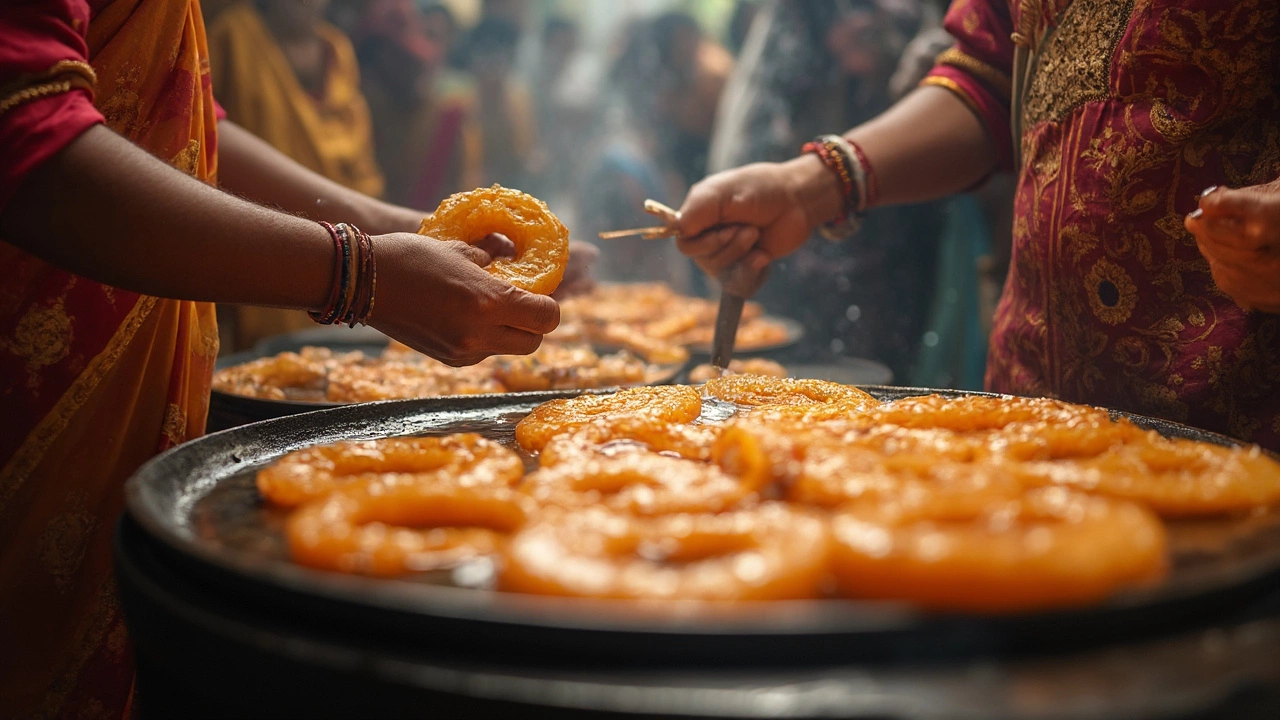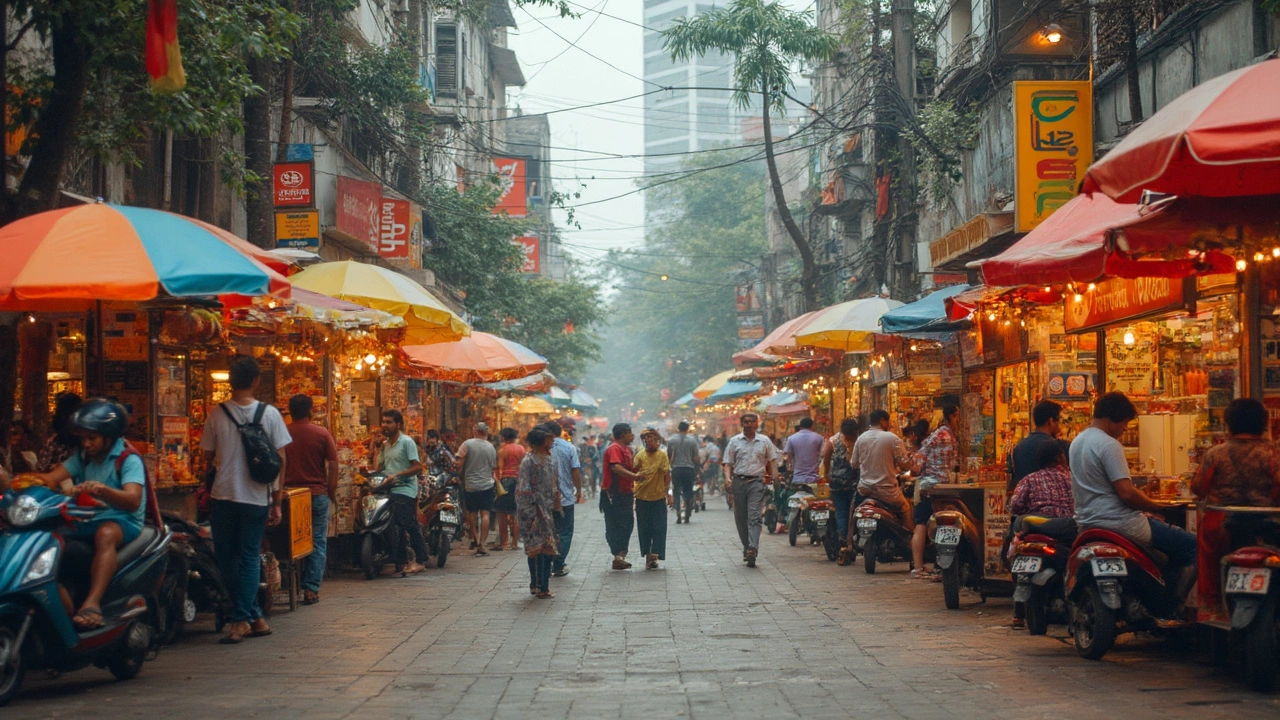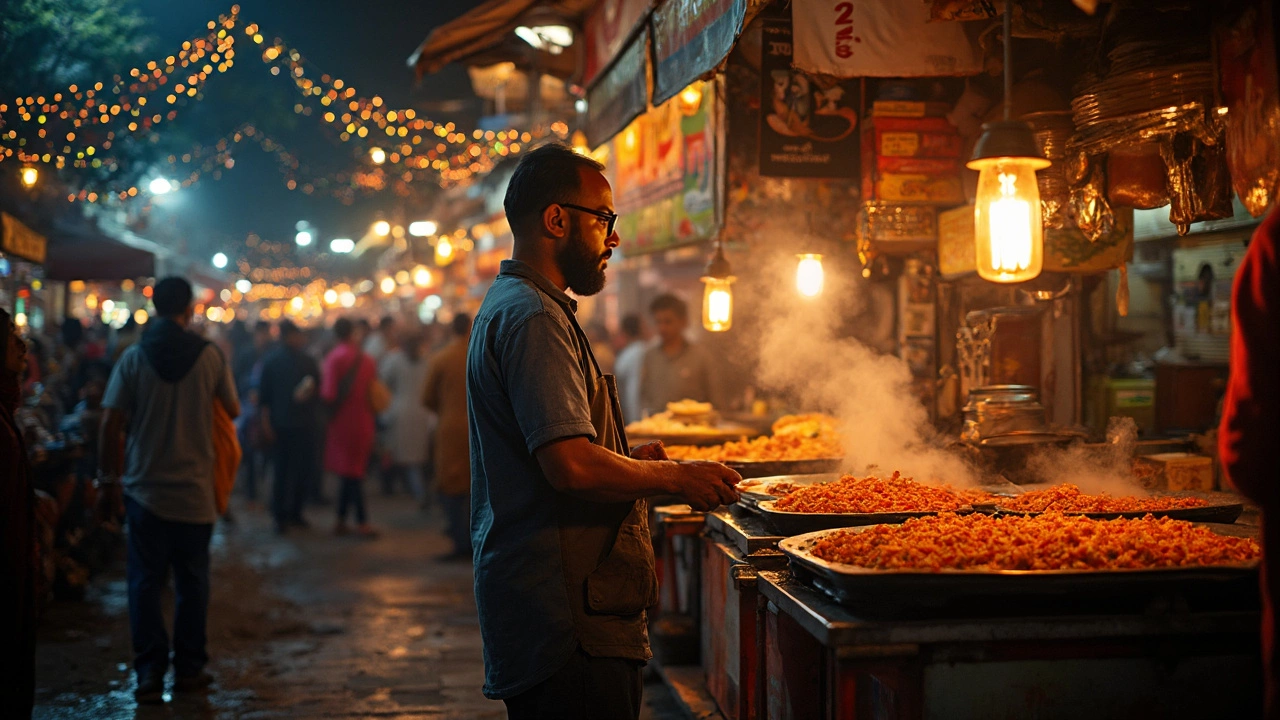Picking the ultimate street food city in India is guaranteed to start a debate at any snack cart. There isn’t just one answer—talk to ten foodies and you’ll get twenty suggestions. But if you want to find out which city truly sets the standard, you'd better know what to look for: wild variety, unbeatable flavor, and that electric street vibe where locals and travelers happily stand in line for the next amazing bite.
Some cities have made street food an art form. The snack scene isn't just about grabbing a quick bite; it’s where you can taste local identity in a plate of piping hot momos, sip a glass of spicy chaas, or snack on sweet jalebis straight from the pan. Want to get the most out of it? Stay open-minded. The best finds aren’t always at fancy markets—in fact, some life-changing eats come from nameless carts tucked into crowded lanes.
- Why Street Food is Big in India
- Top Contender: Kolkata’s Food Scene
- Runners-Up: Delhi and Mumbai
- Insider Tips for Safe and Tasty Snacking
- Street Food Must-Try List
Why Street Food is Big in India
Walk down almost any street in India, and you’ll spot a crowd around a food stall or cart. But it’s not just about taste—it’s about culture, convenience, and affordability. After all, India has over 20 official languages and countless food traditions. Street food became a way for people to try regional flavors without ever leaving their city.
A big reason street food boomed here is the busy lifestyle. People wanted quick, cheap, and filling snacks. For decades, office-goers, students, and travelers have depended on vendors for breakfast, lunch, and even midnight munchies. You can eat a hot samosa in Mumbai for less than ₹20, or slurp an afternoon chai with vada in Delhi for about the same price. Compare that to restaurant meals, and you’ll see why locals stick to the streets.
The other draw is variety. Here’s what makes it special:
- Every region has signature snacks—think Kolkata’s kathi rolls or Gujarat’s dhokla.
- Vendors often use secret spice blends passed down for generations.
- Menus change with the season, so fresh ingredients rule.
Even famous chefs admit—if you want India’s real flavors, street food India is where it’s at. Huge events like college fests or cricket matches often turn into street food hotspots. According to a 2023 survey by FSSAI, there are over 2.5 million licensed street food vendors across Indian cities. That’s a pretty good sign of how big the industry is!
| City | Popular Snack | Average Price (INR) |
|---|---|---|
| Delhi | Chaat | 25 |
| Kolkata | Puchka | 20 |
| Mumbai | Vada Pav | 15 |
| Chennai | Sundal | 20 |
| Lucknow | Tunday Kebab | 35 |
So, next time you travel in India, hunt for the local snack stalls. That’s where you’ll taste the real India, one bite at a time.
Top Contender: Kolkata’s Food Scene
If you’re talking about street food India, Kolkata is almost always in the conversation. In every corner of the city, you'll see tiny stalls, carts squeezed between shops, and hawkers working magic with humble ingredients. The real magic is in the wild mix of flavors—sweet, spicy, sour, often in the same bite. Grazing through Kolkata isn’t just about eating, it’s about joining daily life on the street.
Let’s get specific. Kolkata is home to the original “phuchka,” which beats any pani puri or golgappa for serious crunch and tang. The potato mix inside packs a secret punch of spices and black salt. You can’t walk far without bumping into stands selling kathi rolls—paratha stuffed with grilled meat, egg, or paneer, drizzled with lime and onions. These started out at Nizam’s in the city center and spread like wildfire for good reason: they’re fast, filling, and addictive.
The city’s Chinese community in Tangra serves up hand-pulled noodles and chili chicken, making Chinese-Indian street food a separate obsession. And if you swing by Deshapriya Park or Vivekananda Park in the evening, there’s a crowd clustered around chaat vendors, debating whether the aloo kabli or ghugni is the best snack for under fifty rupees.
- Must-try snacks: phuchka, kathi rolls, egg devil, chanachur, shingara, telebhaja, jhalmuri, momos, paturi, cutlets
- Sweet tooth? Don’t miss mishti doi and roshogolla—local sweets shops like Balaram Mullick or KC Das draw lines for a reason.
People here are picky about freshness, so most food is made right in front of you. If you’re worried about hygiene, look for busy stalls—locals avoid the empty ones for a reason. Most famous vendors have been running for decades, with regulars coming back every day. That’s a pretty solid food review in my book.
| Snack | Typical Price (INR) | Best Spot |
|---|---|---|
| Phuchka | 30-50 for 6 pieces | Vivekananda Park |
| Kathi Roll | 50-120 | Nizam's, Park Street |
| Jhalmuri | 20-30 | Near Esplanade |
| Mishti Doi | 25-50 | Balaram Mullick |
And one more thing—Kolkata’s street food isn’t just about flavor. It’s affordable. For the cost of a single burger at a chain, you can eat like a king here, mixing and matching half a dozen snacks in an evening. That’s what keeps both students and working folks coming back day after day.

Runners-Up: Delhi and Mumbai
While Kolkata might win the title for India’s top street food city, Delhi and Mumbai are right behind and deserve a shout-out. Both cities are legendary for their bustling food scenes, flavors that hit hard, and streets packed with sizzling carts from morning till late night.
Delhi is famous for its chaat culture. You find these spicy, sweet, and tangy treats in markets like Chandni Chowk and Connaught Place. Think aloo tikki, golgappa (pani puri), and papri chaat that make you want to wipe the plate clean. You'll spot queues at Haldiram’s, but the roadside vendors with decades-old family recipes often have the longest lines. A fun fact: Kareem’s near Jama Masjid started back in 1913 and people still swear by its kebabs and biryani, especially after a plate of chaat.
Mumbai isn’t about sitting down for long meals—it’s about eating on the go. Vada pav is the city’s answer to the burger: a spicy potato patty in a bun, usually with a hit of garlic chutney. You can grab one for twenty rupees at Dadar Station and keep walking. Other favorites? Pav bhaji, misal pav, and Bombay sandwich. Don’t leave without trying bhelpuri at Juhu Beach. The sea breeze, the sound of waves, and that mix of puffed rice, tangy chutneys, and crunch make it unforgettable.
- In Delhi, avoid ordering anything pre-made—ask for it fresh. That way you skip sogginess and get the best flavors.
- Mumbai’s street food is best in the evening when the vendors are busiest and freshest. Try the stalls at Chowpatty or Ghatkopar.
- Look for places where locals crowd around. High turnover = fresh, safe food. Your senses—and stomach—will thank you.
Even if you chase street food India for a lifetime, these cities will keep surprising you with something new around every corner. Bring a little cash, a sense of adventure, and maybe an antacid—just in case you can’t stop at one bite.
Insider Tips for Safe and Tasty Snacking
If you’re about to hunt down the best street food India offers, a couple of smart moves will keep you happily munching instead of regretting those extra pani puris. Cleanliness isn’t just about spotless carts—watch for steaming-hot, freshly made stuff. If a snack is being fried or roasted right in front of you, that’s a pretty good sign it’s safe.
Follow the locals. Seriously, if you spot a crowd of office goers or college students at a stall, the food is almost always better (and safer) than that lonely cart on the corner. Local regulars know which vendors keep high standards and which ones cut corners.
Another tip: skip raw stuff like chutneys or water-based drinks if you’re not sure about the hygiene. Bottled water is your friend—bring your own or buy sealed bottles, especially in the middle of a hot day. If you’re extra cautious, ask for food without ice and avoid pre-cut fruits.
- Go for hot, cooked foods—think samosas, kathi rolls, vada pav, and dosa.
- Carry a hand sanitizer or some wet wipes. Not all places will have running water for washing up.
- Ask for a plate or cup, even if it’s a makeshift one, instead of grabbing food straight from the vendor’s hand.
- Don’t be afraid to ask about the ingredients or how long the food’s been sitting out.
Here’s a quick table showing what to pick and what to skip if you’re worried about hygiene:
| Safe Bets | Better to Skip |
|---|---|
| Piping hot pakoras | Raw salads or chutneys |
| Freshly roasted corn (bhutta) | Open-water golgappa (pani puri) in risky areas |
| Baked or grilled snacks | Ice-based drinks from unknown water |
One last thing: avoid peak lunchtime crush if you want to actually chat with the vendor and take your time ordering. Early evening or just before lunch rush can give you a fresher batch and more attention from the cooks. With some smarts and a little caution, you’ll end up with a stomach full of memories—not medicine.

Street Food Must-Try List
If you’re hunting for the best street food India has to offer, there’s a list you can’t ignore. Every city has its legends, but certain snacks have fans lining up again and again. Here’s a guide to the top must-try street foods—make sure you pack an appetite and a sense of adventure.
- Kolkata’s Puchka: These are the Bengali cousins of pani puri, except the stuffing is tangier and the tamarind water is spicier. Ask for an extra round—locals know that the last one, called ‘sukha’, is the best part.
- Delhi’s Chole Bhature: Big, fluffy bhature and spicy chickpeas, often eaten for breakfast. Trust me, nothing beats chole bhature after a chilly Delhi morning walk.
- Mumbai’s Vada Pav: Sometimes called the ‘Indian burger’, this is basically a spicy potato patty inside a bun, with green chutney and a fiery masala. Grab it from a train station vendor—they move so fast, you know it’s fresh.
- Chennai’s Sundal: Popular on city beaches. These are boiled chickpeas tossed with coconut, curry leaves, and a bit of chili. Cheap, filling, and bursting with flavor.
- Ahmedabad’s Dabeli: A sweet and spicy treat with mashed potato, pomegranate seeds, peanuts, and sev stuffed into a bun. It’s crunchy, sweet, and a little bit spicy in every bite.
- Lucknow’s Tunday Kabab: Melt-in-your-mouth minced meat kebabs with secret spices, best eaten hot off the grill with a rumali roti.
- Indore’s Poha Jalebi: Light, fluffy poha (beaten rice) often paired with sweet jalebi for breakfast—a local favorite you won’t find in every other Indian city.
Can’t decide where to start? Here’s a quick table to show you what’s famous, where it comes from, and the average price you’ll pay at a roadside stall:
| Snack | City | Average Price (INR) |
|---|---|---|
| Puchka | Kolkata | 20-30 |
| Chole Bhature | Delhi | 50-80 |
| Vada Pav | Mumbai | 15-25 |
| Sundal | Chennai | 15-30 |
| Dabeli | Ahmedabad | 20-35 |
| Tunday Kabab | Lucknow | 40-60 |
| Poha Jalebi | Indore | 30-50 |
One quick tip—if you see a long line at a stall, don’t be put off. It usually means something special is cooking. And if you want an authentic taste, ask the vendor what their bestseller is or just say “Bhaiya, jo sab le rahe hain wahi de do!” (Give me what everyone’s having!)
